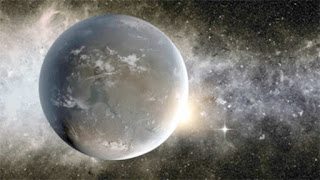"On 14 July 2015, the NASA spacecraft New Horizons flew past Pluto and its moons after a 9½-year, 4.8-billion–km (3-billion–mile) journey from Earth.
The images sent back show a world with an astonishing range of features, including mountains which may be volcanic, areas with some impact craters, a huge flat area with no impact craters at all, dark areas yet to be identified, and blue skies indicating an atmosphere.
Many of these features have been described as ‘puzzling’, because contrary to evolutionists’ expectations, they make Pluto ‘look young’!
--This is because they require it to still be, or have recently been, geologically active.
-x-But this should not be possible for an object of Pluto’s small size. Smaller objects cool off more rapidly, and if the solar system really were the assumed 4.5 billion years old, Pluto would have been ‘cold and dead’ long ago.
Pluto has long been believed to have a rocky core, consistent with its overall density plus evolutionary ideas of how it formed. It is now thought that the core is surrounded by water ice and frozen nitrogen, together with an abundance of frozen methane and frozen carbon monoxide coating the surface.
--A mountain range 3.35 km (2.1 miles) high (rivalling the North American Rockies), and another 1.6 km (1 mile) high, appear to be made of water ice. At Pluto’s frigid temperature of -235º C (-390º F), ice is as hard as rock, so it would have taken a lot of energy for them to have been thrust up so high.
-x-But NASA says they are less than 2% of Pluto’s supposed evolutionary age—which would have them forming at a time when Pluto should have been long since geologically ‘dead’.
Pluto is so small that any primordial heat should have dissipated into space long ago, if it were billions of years old. Since it orbits ~6 billion km (~4 billion miles) from the sun, its surface temperature is about -230º C (~ -380º F)! This is below the freezing point of all gases, except neon, hydrogen, and helium.
--The density of Pluto (38% of Earth’s) is too small to allow for the heavy long-lived radioactive elements to provide heat for billions of years.
--Pluto is not near enough to any other object large enough to cause tidal effects within Pluto and so raise its temperature."
CMI
The images sent back show a world with an astonishing range of features, including mountains which may be volcanic, areas with some impact craters, a huge flat area with no impact craters at all, dark areas yet to be identified, and blue skies indicating an atmosphere.
Many of these features have been described as ‘puzzling’, because contrary to evolutionists’ expectations, they make Pluto ‘look young’!
--This is because they require it to still be, or have recently been, geologically active.
-x-But this should not be possible for an object of Pluto’s small size. Smaller objects cool off more rapidly, and if the solar system really were the assumed 4.5 billion years old, Pluto would have been ‘cold and dead’ long ago.
Pluto has long been believed to have a rocky core, consistent with its overall density plus evolutionary ideas of how it formed. It is now thought that the core is surrounded by water ice and frozen nitrogen, together with an abundance of frozen methane and frozen carbon monoxide coating the surface.
--A mountain range 3.35 km (2.1 miles) high (rivalling the North American Rockies), and another 1.6 km (1 mile) high, appear to be made of water ice. At Pluto’s frigid temperature of -235º C (-390º F), ice is as hard as rock, so it would have taken a lot of energy for them to have been thrust up so high.
-x-But NASA says they are less than 2% of Pluto’s supposed evolutionary age—which would have them forming at a time when Pluto should have been long since geologically ‘dead’.
Pluto is so small that any primordial heat should have dissipated into space long ago, if it were billions of years old. Since it orbits ~6 billion km (~4 billion miles) from the sun, its surface temperature is about -230º C (~ -380º F)! This is below the freezing point of all gases, except neon, hydrogen, and helium.
--The density of Pluto (38% of Earth’s) is too small to allow for the heavy long-lived radioactive elements to provide heat for billions of years.
--Pluto is not near enough to any other object large enough to cause tidal effects within Pluto and so raise its temperature."
CMI

